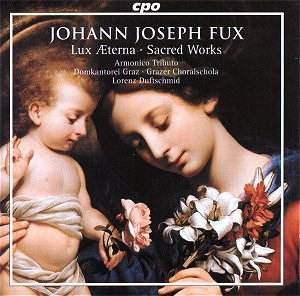The music of Johann Joseph Fux has never sounded as fine
as it does on this new CPO disc of sacred works. Likely better known
for his writings on counterpoint than his compositions, Fux wrote
enjoyable and architecturally sturdy music a few steps up from the
typical baroque fare.
For Fux’s music to create any lasting impression,
it needs very sympathetic and exceptional performances. That is
exactly what Lorenz Duftschmid and company offer with idiomatic
interpretations, incisive rhythmic patterns, pungent period instruments,
and a wonderful chorus. Also, the program is quite diverse with
works for unaccompanied chorus, vocal soloists, and three strictly
instrumental sonatas.
As it happens, the performances are only a part
of the disc’s appeal. I have never encountered such superb sound
engineering and placement of singers and instruments. Each vocal
soloist, choral sub-group, and instrument is given its own space
in a multi-layered presentation. This is a soundstage that wants
to take us to higher echelons of rapture through upward terracing,
and spatial characteristics have never been as expertly planned
and executed.
Taking this a step further, one of the most rewarding
features of sacred choral music is its ability to figuratively
lift us to the heavens. With the new CPO disc, we are constantly
on the rise with each piece of music taking us to new heights.
Among the most delectable works is the "Graduale"
K146. Both it and the first work are for a cappella forces. "Introitus"
is subtle mystery that is taken over in K146 by a higher force
of striking beauty, which includes a section for alto soloist.
If any performance of music can convince me that heaven exists,
the "Graduale" is a viable contender.
The three Fux Sonatas (K320, K376, and K396)
are well placed on the program, and Fux imparts an attractive
blend of lyricism and austerity to his music. The period instruments
have a gorgeous and pungent sound that can’t possibly be matched
by their modern counterparts. In case you are wondering about
the accuracy and logic of mixing sacred choral and instrumental
music, it was common in Fux’s time for both to coexist during
a religious service. The instrumental pieces were used as an enticement
for the choral music and also when the clergy were moving about
within the church.
In conclusion, the music of Fux is not essential
listening, but the new CPO disc is a marvel of engineering with
performances that are entirely top-rate including the sublime
contributions from the five vocal soloists. For these reasons,
the disc is urgently recommended to baroque music enthusiasts
and audiophiles.
Don Satz


![]() Lorenz Duftschmid, Director
Lorenz Duftschmid, Director
![]() CPO 999 850-2 [54:24]
CPO 999 850-2 [54:24]